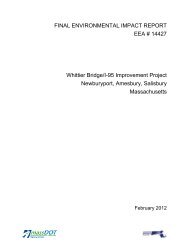Herbicide Alternatives Research - Executive Office of Transportation
Herbicide Alternatives Research - Executive Office of Transportation
Herbicide Alternatives Research - Executive Office of Transportation
Create successful ePaper yourself
Turn your PDF publications into a flip-book with our unique Google optimized e-Paper software.
1. Report No.<br />
SPRII03.23<br />
4. Title and Subtitle<br />
<strong>Herbicide</strong> <strong>Alternatives</strong> <strong>Research</strong><br />
Technical Report Document Page<br />
2. Government Accession No.<br />
n/a<br />
3. Recipient's Catalog No.<br />
n/a<br />
5. Report Date<br />
July 2008<br />
6. Performing Organization Code<br />
n/a<br />
7. Author(s) Allen V. Barker and Randall G. Prostak 8. Performing Organization Report No.<br />
9. Performing Organization Name and Address<br />
University <strong>of</strong> Massachusetts <strong>Transportation</strong> Center<br />
214 Marston Hall<br />
130 Natural Resources Road<br />
Amherst, Massachusetts 01003<br />
12. Sponsoring Agency Name and Address<br />
<strong>Executive</strong> <strong>Office</strong> <strong>of</strong> <strong>Transportation</strong> and Public Works<br />
10 Park Plaza, Room 4150<br />
Boston, Massachusetts 02116<br />
15. Supplementary Notes<br />
UMTC-07-02<br />
10. Work Unit No. (TRAIS)<br />
n/a<br />
11. Contract or Grant No.<br />
ISA # 5MS3378<br />
13. Type <strong>of</strong> Report and Period Covered<br />
Final Report<br />
August 17, 2004 to June 30, 2007<br />
14. Sponsoring Agency Code<br />
n/a<br />
16. Abstract<br />
Management <strong>of</strong> vegetation is an important element <strong>of</strong> roadside maintenance for safety and aesthetics. Management<br />
techniques depend on many factors, which include the desired appearance <strong>of</strong> the roadside, the desired type <strong>of</strong> vegetation,<br />
roadway location, traffic, soil and topographic conditions, and adjacent land use. As part <strong>of</strong> its Vegetation Management<br />
Plan, the Massachusetts Highway Department has committed to exploring ways to minimize the use <strong>of</strong> herbicides and<br />
contracted with the University <strong>of</strong> Massachusetts to explore alternatives to conventional herbicides in management <strong>of</strong> vegetation.<br />
Based on the review <strong>of</strong> the literature and results <strong>of</strong> the review <strong>of</strong> vegetation management practices by other state departments <strong>of</strong><br />
transportation, several methods <strong>of</strong> management were selected for investigation. Feasibility <strong>of</strong> successful use, environmental<br />
concerns, and budgetary factors were considered in selection <strong>of</strong> methods to investigate. These methods included use <strong>of</strong><br />
herbicides that are alternatives to conventional, chemical herbicides and use <strong>of</strong> mechanical treatments <strong>of</strong> mulches, hot water,<br />
fire, and mowing. These methods were evaluated in greenhouses, on roadside sites, and in field plots on a research farm.<br />
Alternative methods were compared with use <strong>of</strong> conventional herbicides to assess relative efficacy <strong>of</strong> treatments. <strong>Research</strong> was<br />
conducted for two years. Alternative herbicides that demonstrated immediate or short-term suppression <strong>of</strong> growth <strong>of</strong> vegetation<br />
were pelargonic acid and clove oil. However, the immediate foliar damage after spraying <strong>of</strong> pelargonic acid was much more<br />
injurious than the injury from clove oil. These materials had efficacy against herbaceous plants and woody vines. The efficacy<br />
lasted for three to six weeks after which growth was not distinguishable from untreated vegetation. Repeated applications <strong>of</strong><br />
these herbicides will be necessary for season-long efficacy. Formulations <strong>of</strong> citric-acetic acid or a citrus-derived product<br />
(limonene) gave no control or only weak suppression <strong>of</strong> vegetative growth soon after application, and no suppression was<br />
evident after three to six weeks. Steam or hot water sprayed by implements was effective against herbaceous vegetation but not<br />
against woody species. Efficacy <strong>of</strong> heat treatments, including torching, lasted for three to six weeks. Mulches <strong>of</strong> bark or<br />
woodchips were strongly suppressive against emerging vegetation and suppressed growth for two years. Because <strong>of</strong> the cost <strong>of</strong><br />
materials and labor and need for repeated seasonal applications, all <strong>of</strong> the alternative practices will cost substantially more than<br />
the use <strong>of</strong> conventional herbicides.<br />
17. Key Word<br />
Roadside vegetation, vegetation management, weed control,<br />
alternative herbicides, organic herbicides, mechanical weed<br />
control, mulches, thermal weed control<br />
19. Security Classif. (<strong>of</strong> this report)<br />
Unclassified<br />
20. Security Classif. (<strong>of</strong> this page)<br />
Unclassified<br />
Form DOT F 1700.7 (8-72) Reproduction <strong>of</strong> completed page authorized<br />
i<br />
18. Distribution Statement<br />
Unrestricted<br />
21. No. <strong>of</strong> Pages<br />
238<br />
22. Price<br />
n/a
















